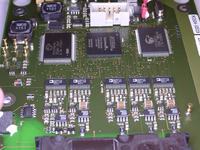MAAASD
Member level 4
heey all,
Suppose, i've just finished my project in vhdl and tested it
and i've made timing simulation and it's all okey
i need now to see my project in real life
i mean in hardware, how can i have a hardware equivalent to my vhdl project?
what are the methods(fabrication techniques) (in details) to do that?
any information would be great i'm beginner in digital design
your help is much more appreciated
thanks!
Suppose, i've just finished my project in vhdl and tested it
and i've made timing simulation and it's all okey
i need now to see my project in real life
i mean in hardware, how can i have a hardware equivalent to my vhdl project?
what are the methods(fabrication techniques) (in details) to do that?
any information would be great i'm beginner in digital design
your help is much more appreciated
thanks!
